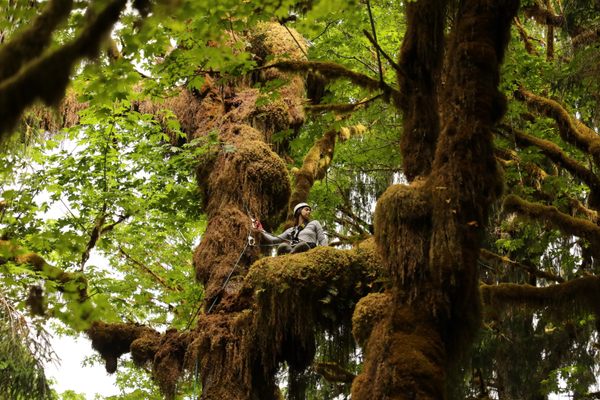Where Are Europe’s Last Fairytale Forests?
Mapping the oldest and least-disturbed tracts of trees is easier said than done.

In Kay Nielsen’s illustrations for the Brothers Grimm story of Hansel and Gretel, the deep woods are full of secrets. The trees are towering, gnarled, and knotted. Their canopies, crunchy and brown, blot out the sky. On the ground, clusters of ferns unfurl around tree roots; there are patches of grass, and verdant trees studded with blooms. In a glen, of course, sits that devilishly tasty house built from bread and cakes.
The woods are a character in the story. They are thick, tall, and deep—so much so that the young duo could wander them for days. Their allure, and a dash of horror, comes from the fact that they are unknown, and maybe unknowable.
In 2018, they aren’t many truly unknown corners of the globe—few places are pristine and untraveled the way they might be described in a fairytale. Still, dense clusters of primary forests—where trees have grown, for ages, largely undisturbed—exist in patches of the Amazon basin, Southeast Asia, and Canadian and Siberian Taiga. Slivers of Europe are still luxuriant with trees, too, and very old ones at that. But they’re dwindling.
A team of researchers, led by Francesco Maria Sabatini of Berlin’s Humboldt‐Universität, recently set out to map exactly where those oldest, least-disturbed forests are, and how many of them are left.

Since focusing on utterly untrammeled forest would have yielded a very brief list, the team took a broader view. They reviewed 17 years’ worth of studies on primary forests, which they took to include any tracts that were “primeval, virgin, near‐virgin, old‐growth, [or] long‐untouched.”
When they analyzed that data, the researchers found that most of the primary forests—at least those for which they had records—sprouted in Finland, or on the Carpathian or Balkan mountain ranges that slice across Romania and Bulgaria. Even where they’re most plentiful, these aren’t huge or especially numerous. Known primary forests account for just 0.7 percent of Europe’s forest area, discounting Russia, the scientists write in a new paper describing their results. So, unsurprisingly, these are small parcels—the median was 24 hectares, or roughly 0.09 square miles—largely scattered in northern latitudes, far from roads and among rugged terrain. Remote location and low density also makes it likely that the lumber industry hadn’t rumbled through town.
Still, the authors caution that this is certainly only a partial picture of the distribution. “Some of the patterns that can be seen in the map derive from data availability, rather than reflecting the actual distribution of primary forests,” Sabatini says. There was no data for Latvia, Belarus, Moldova, or Ireland, and just scattered snapshots for Sweden, Austria, or the U.K. It’s quite possible that there are primary forests there that didn’t make it into the mix because the data wasn’t available. To begin to account for that, the researchers also modeled areas where they suspect that unrecorded forests are most likely to be.
“There’s a recent surge of interest on Europe’s remaining wild areas,” Sabatini says, and there are ecological reasons for pinpointing where they are and what protections insulate them. For animals that thrive in primeval forests, a changing landscape can be disastrous. The western capercaillie bird, for instance, depends on “a mosaic dominated by old-growth, natural forests, mixed with bogs and younger successional stages,” Sabatini says. His colleague Martin Mikoláš, a forest ecologist at the Czech University of Life Sciences, found that when the bird’s habitat in Slovakia’s Low Tatra mountains decreased by 7,000 hectares, the population plummeted by 40 percent.

Many of these areas that are already recorded don’t sit within areas governed by strict protections. Governments sometimes skirt those regulations, anyway, and that’s already causing conflicts. Back in 2012, spruce bark beetles infested some of the centuries-old trees in Poland’s Białowieża Forest, an old-growth cluster and UNESCO heritage site home to wolves, lynx, and many other species. Poland’s government green-lit a massive logging project, ostensibly to contain and defeat the menace. As many as 100,000 trees were felled in the process, and more than a few researchers felt they’d been duped—that the effort had been a lumber project dressed up as a conservation one. “Logging of infested spruces does not stop a bark beetle outbreak, it just leaves thousands of hectares of clear-felled sites instead,” Bogdan Jaroszewicz, a researcher at the University of Warsaw and director of the Białowieża research station, told The Guardian. In April, the European Union mandated that the chainsaws stop buzzing, but it’s unclear what happens next.
Re-naturalization projects are often controversial, and Sabatini says there’s probably no “right answer” about how to pull them off. The best approach will vary by place and conditions. If the goal is to buoy species that are struggling to find habitat, he says, one tactic might be creating proxies for natural deadwood, and carving cavities into trees to give bats, woodpeckers, and other birds a spot to nest. In other instances, a hands-off strategy might be better.
In any case, returning a forest to its primeval state isn’t feasible, and it takes decades to even get close. “Restoring primary forest is important—for many forest types there’s simply no primary forest left, at least in Europe—but preserving what’s left is crucial,” Sabatini says. “Once a forest loses its primary status, there’s not much you can do, except waiting hundreds of years until the signs of human activities blur.”
The best way to explore what Sabatini describes as “last-of-their-kind patches” might be in the pages of storybooks, or in the chapters of our imagination. Perhaps the “best way to express one’s love to these wild areas,” he says, “is to keep them wild.”


















Follow us on Twitter to get the latest on the world's hidden wonders.
Like us on Facebook to get the latest on the world's hidden wonders.
Follow us on Twitter Like us on Facebook